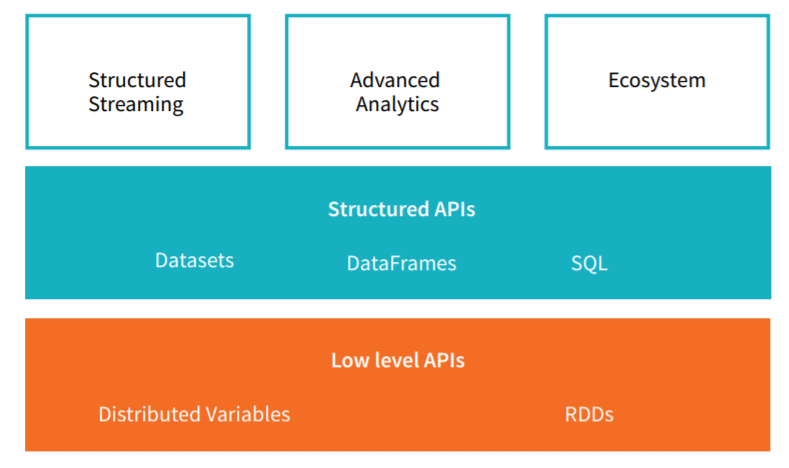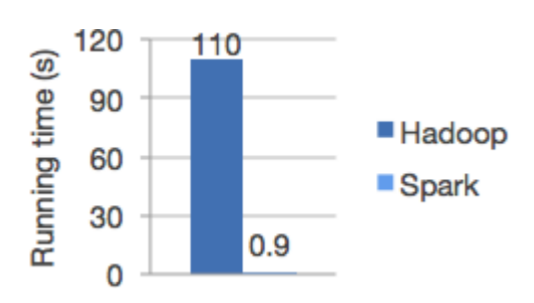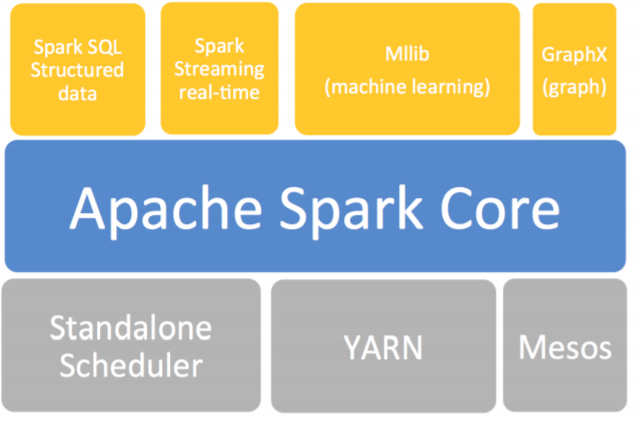Apache Spark is a unified computing engine and a set of libraries for parallel data processing on computer clusters. As of the time this writing, Spark is the most actively developed open source engine for this task; making it the de facto tool for any developer or data scientist interested in big data. Spark supports multiple widely used programming languages (Python, Java, Scala and R), includes libraries for diverse tasks ranging from SQL to streaming and machine learning, and runs anywhere from a laptop to a cluster of thousands of servers. This makes it an easy system to start with and scale up to big data processing or incredibly large scale.

Why Spark?
I think the following four main reasons from Apache Spark official website are good enough to convince you to use Spark.
1. Speed
Run programs up to 100x faster than Hadoop MapReduce in memory, or 10x faster on disk. Apache Spark has an advanced DAG execution engine that supports acyclic data flow and in-memory computing. Spark has pursued the goal of speed in several ways. First, its internal implementation benefits immensely from the hardware industry’s recent huge strides in improving the price and performance of CPUs and memory. Today’s commodity servers come cheap, with hundreds of gigabytes of memory, multiple cores, and the underlying Unix-based operating system taking advantage of efficient multithreading and paral‐ lel processing. The framework is optimized to take advantage of all of these factors. Second, Spark builds its query computations as a directed acyclic graph (DAG); its DAG scheduler and query optimizer construct an efficient computational graph that can usually be decomposed into tasks that are executed in parallel across workers on the cluster. And third, its physical execution engine, Tungsten, uses whole-stage code generation to generate compact code for execution. With all the intermediate results retained in memory and its limited disk I/O, this gives it a huge performance boost.
Logistic regression in Hadoop and Spark :

2. Ease of Use
Write applications quickly in Java, Scala, Python, R Spark offers over 80 high-level operators that make it easy to build parallel apps. And you can use it interactively from the Scala, Python and R shells. Spark achieves simplicity by providing a fundamental abstraction of a simple logical data structure called a Resilient Distributed Dataset (RDD) upon which all other higher-level structured data abstractions, such as DataFrames and Datasets, are con‐ structed. By providing a set of transformations and actions as operations, Spark offers a simple programming model that you can use to build big data applications in familiar languages.
3. Generality
Combine SQL, streaming, and complex analytics. Spark powers a stack of libraries including SQL and DataFrames, MLlib for machine learning, GraphX, and Spark Streaming. You can combine these libraries seamlessly in the same application. Spark operations can be applied across many types of workloads and expressed in any of the supported programming languages: Scala, Java, Python, SQL, and R. Spark offers unified libraries with well-documented APIs that include the following mod‐ ules as core components: Spark SQL, Spark Structured Streaming, Spark MLlib, and GraphX, combining all the workloads running under one engine. We’ll take a closer look at all of these in the next section. You can write a single Spark application that can do it all—no need for distinct engines for disparate workloads, no need to learn separate APIs. With Spark, you get a unified processing engine for your workloads.
The Spark stack :

4. Runs
Everywhere Spark runs on Hadoop, Mesos, standalone, or in the cloud. It can access diverse data sources including HDFS, Cassandra, HBase, and S3. Spark focuses on its fast, parallel computation engine rather than on storage. Unlike Apache Hadoop, which included both storage and compute, Spark decouples the two. That means you can use Spark to read data stored in myriad sources Apache Hadoop, Apache Cassandra, Apache HBase, MongoDB, Apache Hive, RDBMSs, and more and process it all in memory. Spark’s Data Frame Readers and Data Frame Writers can also be extended to read data from other sources, such as Apache Kafka, Kinesis, Azure Storage, and Amazon S3, into its logical data abstraction, on which it can operate. The community of Spark developers maintains a list of third-party Spark packages as part of the growing ecosystem. This rich ecosystem of packages includes Spark connectors for a variety of external data sources, performance monitors, and more.
Description of Apache Spark :–
A unified, computing engine and set of libraries for big data – into its key components.
Unified:
Spark’s key driving goal is to offer a unified platform for writing big data applications. What do we mean by unified? Spark is designed to support a wide range of data analytics tasks, ranging from simple data loading and SQL queries to machine learning and streaming computation, over the same computing engine and with a consistent set of APIs. The main insight behind this goal is that real-world data analytics tasks whether they are interactive analytics in a tool such as a Jupyter notebook, or traditional software development for production applications tend to combine many different processing types and libraries. Spark’s unified nature makes these tasks both easier and more efficient to write. First, Spark provides consistent, composable APIs that can be used to build an application out of smaller pieces or out of existing libraries, and makes it easy for you to write your own analytics libraries on top. However, composable APIs are not enough: Spark’s APIs are also designed to enable high performance by optimizing across the different libraries and functions composed together in a user program. For example, if you load data using a SQL query and then evaluate a machine learning model over it using Spark’s ML library, the engine can combine these steps into one scan over the data. The combination of general APIs and high-performance execution no matter how you combine them makes Spark a powerful platform for interactive and production applications. Spark’s focus on defining a unified platform is the same idea behind unified platforms in other areas of software. For example, data scientists benefit from a unified set of libraries (e.g., Python or R) when doing modeling, and web developers benefit from unified frameworks such as Node.js or Django. Before Spark, no open source systems tried to provide this type of unified engine for parallel data processing, meaning that users had to stitch together an application out of multiple APIs and systems. Thus, Spark quickly became the standard for this type of development. Over time, Spark has continued to expand its built-in APIs to cover more workloads. At the same time the project’s developers have continued to refine its theme of a unified engine. In particular, one major focus of this book will be the “structured APIs” (DataFrames, Datasets and SQL) that were finalized in Spark 2.0 to enable more poweful optimization under user applications.
Computing Engine :
At the same time that Spark strives for unification, Spark carefully limits its scope to a computing engine. By this, we mean that Spark only handles loading data from storage systems and performing computation on it, not permanent storage as the end itself. Spark can be used with a wide variety of persistent storage systems, including cloud storage systems such as Azure Storage and Amazon S3, distributed file systems such as Apache Hadoop, key-value stores such as Apache Cassandra, and message buses such as Apache Kafka. However, Spark neither stores data long-term itself, nor favors one of these. The key motivation here is that most data already resides in a mix of storage systems. Data is expensive to move so Spark focuses on performing computations over the data, no matter where it resides. In user-facing APIs, Spark works hard to make these storage systems look largely similar so that applications do not have to worry about where their data is. Spark’s focus on computation makes it different from earlier big data software platforms such as Apache Hadoop. Hadoop included both a storage system (the Hadoop file system, designed for low-cost storage over clusters of commodity servers) and a computing system (MapReduce), which were closely integrated together. However, this choice makes it hard to run one of the systems without the other, or even more importantly, to write applications that access data stored anywhere else. While Spark runs well on Hadoop storage, it is also now used broadly in environments where the Hadoop architecture does not make sense, such as the public cloud (where storage can be purchased separately from computing) or streaming applications.
Libraries :
Spark’s final component is its libraries, which build on its design as a unified engine to provide a unified API for common data analysis tasks. Spark supports both standard libraries that ship with the engine, and a wide array of external libraries published as third-party packages by the open source communities. Today, Spark’s standard libraries are actually the bulk of the open source project: the Spark core engine itself has changed little since it was first released, but the libraries have grown to provide more and more types of functionality. Spark includes libraries for SQL and structured data (Spark SQL), machine learning (MLlib), stream processing (Spark Streaming and the newer Structured Streaming), and graph analytics (GraphX). Beyond these libraries, there hundreds of open source external libraries ranging from connectors for various storage systems to machine learning algorithms.
Future of Spark
Spark has been around for a number of years at this point but continues to gain massive popularity. Many new projects within the Spark ecosystem continue to push the boundaries of what’s possible with the system. For instance a streaming engine (Structured Streaming) was built and introduced into Spark in 2017 and 2017. This technology is a huge apart of companies solving massive scale data challenges, from technology companies like Uber and Netflix leveraging Spark’s streaming engines and machine learning tools to institutions like the Broad Institute of MIT and Harvard leveraging Spark for genetic data analysis. Spark will continue to be a cornerstone of companies doing big data analysis for the foreseeable future, especially since Spark is still in its infancy. Any data scientist or data engineer that needs to solve big data problems needs a copy of Spark on their machine and a copy of this book on their bookshelf.
- Log in to post comments